thomas jefferson
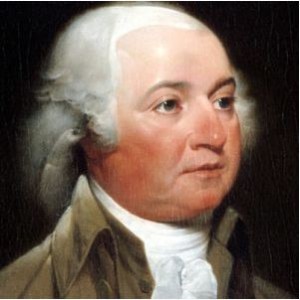
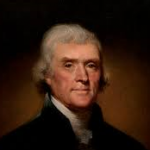 With the election of Thomas Jefferson as third president, on February 17, 1801, came the first peaceful transfer of power from one political party to another in the United States. Nevertheless, the election was an unusual one. By this time, Jefferson had helped to draft the Declaration of Independence, had served in two Continental Congresses, as minister to France, as secretary of state under George Washington and as John Adams’ vice president. These credentials probably made him the best person for the job in the entire world.
With the election of Thomas Jefferson as third president, on February 17, 1801, came the first peaceful transfer of power from one political party to another in the United States. Nevertheless, the election was an unusual one. By this time, Jefferson had helped to draft the Declaration of Independence, had served in two Continental Congresses, as minister to France, as secretary of state under George Washington and as John Adams’ vice president. These credentials probably made him the best person for the job in the entire world.
While it was obvious that Jefferson was the best man for the job, vicious partisan warfare was the name of the game during the campaign of 1800 between Democratic-Republicans Jefferson and Aaron Burr and Federalists John Adams, Charles C Pinckney and John Jay. The ongoing battle raged between Democratic-Republican supporters of the French, who were involved in their own bloody revolution, and the pro-British Federalists who wanted to implement English-style policies in American government. The Federalists hated the French revolutionaries because of their overzealous use of the guillotine and, as a result, were less forgiving in their foreign policy toward the French. They pushed for a strong centralized government, a standing military, and financial support of emerging industries.
Jefferson’s Democratic-Republicans, on the other hand, preferred limited government, complete and absolute states’ rights and a primarily agricultural economy. They feared that Federalists would abandon revolutionary ideals and revert to the English monarchical tradition. When Jefferson was secretary of state under Washington, he opposed Secretary of the Treasury Hamilton’s proposal to increase military expenditures and resigned when Washington supported the leading Federalist’s plan for a national bank.
A bloodless, but ugly campaign ensued, in which candidates and influential supporters on both sides used the press, often anonymously, as a forum to fire slanderous volleys at each other. It sounds a lot like some of our election campaigns of today. Then came the laborious and confusing process of voting, that began in April 1800. Individual states scheduled elections at different times, which I think further confuses the situation, and although Jefferson and Burr ran on the same ticket, as president and vice president respectively, the Constitution still demanded votes for each individual to be counted separately. As a result, by the end of January 1801, Jefferson and Burr emerged tied at 73 electoral votes apiece. Adams came in third at 65 votes. While that left Adams out, it left a tie for Jefferson and Burr. The result created a big problem.
The resulting tie sent the final vote to the House of Representatives. That would not make for an easy decision e ither. A number of those in the Federalist-controlled House of Representatives insisted on following the Constitution’s flawed rules and refused to elect Jefferson and Burr together on the same ticket. The highly influential Federalist Alexander Hamilton, who mistrusted Jefferson, but hated Burr more, persuaded the House to vote against Burr, whom he called the most unfit man for the office of president. Of course, that cause a hatred between Hamilton and Burr that led Burr to challenge Hamilton to a duel in 1804. Burr won the duel when he killed Hamilton. Two weeks before the scheduled inauguration, Jefferson emerged victorious, and Burr was confirmed as his vice president. It was the first of only two times the presidency has been decided by the House of Representatives.
ither. A number of those in the Federalist-controlled House of Representatives insisted on following the Constitution’s flawed rules and refused to elect Jefferson and Burr together on the same ticket. The highly influential Federalist Alexander Hamilton, who mistrusted Jefferson, but hated Burr more, persuaded the House to vote against Burr, whom he called the most unfit man for the office of president. Of course, that cause a hatred between Hamilton and Burr that led Burr to challenge Hamilton to a duel in 1804. Burr won the duel when he killed Hamilton. Two weeks before the scheduled inauguration, Jefferson emerged victorious, and Burr was confirmed as his vice president. It was the first of only two times the presidency has been decided by the House of Representatives.
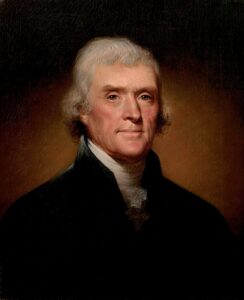 Many people have had to switch from their dominant hand due to an accident, stroke, or amputation, but we rarely think of a president find himself in that position. Nevertheless, Thomas Jefferson had to do just that. It can happen to anyone really, but like many a young man, Thomas Jefferson was out to impress a girl. The strange part was that when it happened, Thomas wasn’t a young man. He was, nevertheless, trying to impress a girl. Thomas was 42 years old. He wasn’t the president of the United States yet, but he had been married. He married Martha Wayles in 1772, but she passed away in 1782, so he was alone. He and Martha had six children. Of the six children born to Thomas and Martha, only two survived to adulthood, Martha and Mary. His wife, Martha died four months after the birth of her last child. He had been happy, but his marriage was short. Thomas Jefferson was not perfect, and in fact he made lots of mistakes, and even had children with his slave, but he was a good president…and which of us is perfect, after all.
Many people have had to switch from their dominant hand due to an accident, stroke, or amputation, but we rarely think of a president find himself in that position. Nevertheless, Thomas Jefferson had to do just that. It can happen to anyone really, but like many a young man, Thomas Jefferson was out to impress a girl. The strange part was that when it happened, Thomas wasn’t a young man. He was, nevertheless, trying to impress a girl. Thomas was 42 years old. He wasn’t the president of the United States yet, but he had been married. He married Martha Wayles in 1772, but she passed away in 1782, so he was alone. He and Martha had six children. Of the six children born to Thomas and Martha, only two survived to adulthood, Martha and Mary. His wife, Martha died four months after the birth of her last child. He had been happy, but his marriage was short. Thomas Jefferson was not perfect, and in fact he made lots of mistakes, and even had children with his slave, but he was a good president…and which of us is perfect, after all.
In 1785, Thomas was in Paris, and he met a woman named Maria Cosway, who was a married woman. Thomas Jefferson took a liking to her, and he was trying to impress her. Well, he shouldn’t have been doing what he did. He knew it, and we know it to this day, but he did try to impress her, by trying to jump over a fence. In the ensuing accident, whereby he fell, Thomas Jefferson broke his right wrist. The surgeon set his wrist, but he didn’t really do a good job of it. After they set his wrist bones, he suffered chronic pain in his left hand for the rest of his life. He was really unable to use his left hand much at all after that. 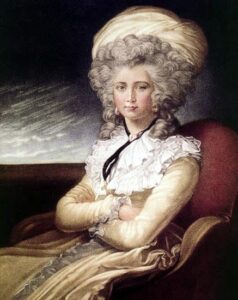
The accident forced Thomas Jefferson to stay in his house for a month, during which time, his secretary, William Short, had to write his letters for him. For a few months, he used his left hand to write letters including the famous “Head and Heart” letter on October 12 to Maria Cosway. The broken wrist caused him to have to cut short the planned sightseeing trip with Maria Cosway, and it also cause him to have to postpone his journey to the south of France. In the end, his wrist finally healed, but it was never to the point that he could use it as his dominant hand, so he had to switch out his dominant hand and live the rest of his life as a lefty. I suppose some might have said that his infatuation with Maria Cosway cost him the use of his hand, in a sort of “repercussion for bad behavior” scenario, but I don’t believe in the “God will hit you with a lightning bolt” kind of punishment. I know that it likely wouldn’t have happened if he had left Maria Cosway alone, but I just think God tries for grace first.
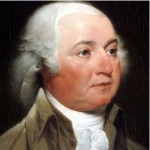
 Historians, who have studied the lives of Presidents John Adams and Thomas Jefferson, agree that while the two men were friends, they also had a long history as “frenemies.” It is fairly common with politicians, because each one has definite ideas about how things should be run. So, the two rivals always had a volatile relationship.
Historians, who have studied the lives of Presidents John Adams and Thomas Jefferson, agree that while the two men were friends, they also had a long history as “frenemies.” It is fairly common with politicians, because each one has definite ideas about how things should be run. So, the two rivals always had a volatile relationship.
Their friendship began in the early days of the nation, despite their vastly different political views. Adams was a strong believer in a strong central government, and Jefferson championed states’ rights. I would imagine that there was a measure of frustration for Adams, as he watched his administration being dismantled in the early years of the Jefferson administration. Nevertheless, as a Conservative, I have to agree with the Thomas Jefferson way of government.
Adams preceded Jefferson as president friend 1797 to 1800. During the Adams presidency, it became very apparent that the two men were very different, and their political views were just as different. The hot-tempered Adams was a firm believer in a strong centralized government, while the genteel Jefferson believed federal government should take a more hands-off approach and defer to individual states’ rights. They clashed loudly and often. As Adams’ vice president, Jefferson was horrified by what he considered to be Adams’ abuse  of the presidential power…particularly his passage of the restrictive Alien and Sedition Acts of 1798. Jefferson abandoned Adams and Washington for his estate at Monticello. There, he plotted how to bring his Republican faction back into power in the presidential election of 1800. After an exceptionally bitter campaign, in which both parties engaged in slanderous attacks on each other in print, Jefferson emerged victorious. It appeared the former friends would be eternal enemies. The former revolutionaries went on to resume their friendship over 14 years of correspondence during their golden years.
of the presidential power…particularly his passage of the restrictive Alien and Sedition Acts of 1798. Jefferson abandoned Adams and Washington for his estate at Monticello. There, he plotted how to bring his Republican faction back into power in the presidential election of 1800. After an exceptionally bitter campaign, in which both parties engaged in slanderous attacks on each other in print, Jefferson emerged victorious. It appeared the former friends would be eternal enemies. The former revolutionaries went on to resume their friendship over 14 years of correspondence during their golden years.
On July 4, 1826, the 50th anniversary of the adoption of The Declaration of Independence, these “frenemies” died on the same day and within five hours of each other. Jefferson and Adams were the last surviving members of the original American revolutionaries who had stood up to the British empire and forged a new political system in the former colonies. When Adams died at the age of 90, his last words, as the country celebrated Independence Day were, “Thomas Jefferson still survives.” Adams was wrong. Jefferson had died five hours earlier at Monticello at the age of 83.
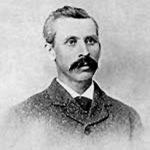 Shortly after President Thomas Jefferson completed the Louisiana Purchase from France, which made it an American territory, William Ashley, who was a Virginia native, made the decision to move to Missouri. Ashley was a young man, who was looking to make a name for himself. He entered into a partnership with Andrew Henry to manufacture gunpowder and lead. Opportunists, Ashley and Henry took advantage of the fact that these two commodities were in short supply in young America.
Shortly after President Thomas Jefferson completed the Louisiana Purchase from France, which made it an American territory, William Ashley, who was a Virginia native, made the decision to move to Missouri. Ashley was a young man, who was looking to make a name for himself. He entered into a partnership with Andrew Henry to manufacture gunpowder and lead. Opportunists, Ashley and Henry took advantage of the fact that these two commodities were in short supply in young America.
Ashley’s business prospered during the War of 1812, and he also joined the Missouri militia. He eventually achieved the rank of general. When Missouri became a state in 1822, Ashley used his military fame, and his business success to win election at lieutenant governor. Once elected, Ashley set about looking for opportunities to enrich both Missouri and his own pocketbook. Because he knew the area, he realized that Saint Louis was in a perfect place to exploit the fur trade on the upper Missouri River.
Ashley recruited his old business partner, Henry to join him in this new venture. Then, Ashley placed an advertisement in the Missouri Gazette and Public Advisor seeking 100 “enterprising young men” to engage in fur trading on the Upper Missouri. The advertisement was a big success. Scores of young men responded and came to Saint Louis. Among them were such future legendary mountain men as Jedediah Smith and Jim Bridger, as well as the famous river man Mike Fink. In time, these men and dozens of others would go on to uncover many of the geographic mysteries of the Far West, but for now they were looking to make a living trapping animals for their furs.
1822 found Ashley and a small band of his fur trappers building a trading post on the Yellowstone River in Montana in order to expand outward from the Missouri River. The Arikara Indians didn’t like this invasion, and they were deeply hostile to Ashley’s attempts to undercut their long-standing position as middlemen in the fur trade. The ensuing attacks eventually forced the men to abandon the Yellowstone post. Out of desperation, Ashley hit on a new strategy. Instead of building central permanent forts along the major rivers, he decided to send his trappers overland in small groups traveling by horseback. By avoiding the river arteries, the trappers could both escape detection by hostile Indians and develop new and untapped fur regions. Almost by accident, Ashley invented the famous “rendezvous” system that revolutionized the American fur trade. The necessary supplies were delivered and furs were delivered at meetings in a large meadow near the Henry’s Fork of Wyoming’s Green River in the early summer of 1825.
Ashley’s first fur trapper rendezvous was very successful. Ashley took home a tidy profit for his efforts. The fur 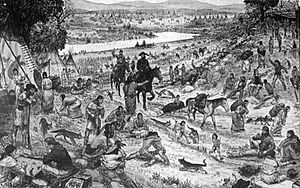 trappers not only had an opportunity to trade for supplies, but a chance to enjoy a few weeks of often drunken socializing. Ashley organized a second highly profitable rendezvous in 1826, and then decided to sell out. While he was no longer a part of it, his rendezvous system continued to be used by others. The system eventually became the foundation for the powerful Rocky Mountain Fur Company. With plenty of money in the bank, Ashley was able to return to his first love…politics. He was elected to Congress three times and once to the Senate, where he helped further the interests of the western land that had made him rich.
trappers not only had an opportunity to trade for supplies, but a chance to enjoy a few weeks of often drunken socializing. Ashley organized a second highly profitable rendezvous in 1826, and then decided to sell out. While he was no longer a part of it, his rendezvous system continued to be used by others. The system eventually became the foundation for the powerful Rocky Mountain Fur Company. With plenty of money in the bank, Ashley was able to return to his first love…politics. He was elected to Congress three times and once to the Senate, where he helped further the interests of the western land that had made him rich.
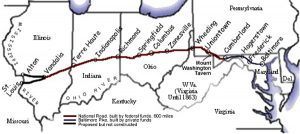
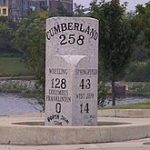 George Washington and Thomas Jefferson believed that a trans-Appalachian road was necessary to connect this young country. In 1806 Congress authorized construction of the road and President Jefferson signed the act establishing the National Road. It would connect Cumberland, Maryland to the Ohio River. Construction on the road, known in many places as Route 40, and in others as the Cumberland Road, began in 1811 and continued until 1834. It was designed to reach the western settlements, and was the first federally funded road in United States history.
George Washington and Thomas Jefferson believed that a trans-Appalachian road was necessary to connect this young country. In 1806 Congress authorized construction of the road and President Jefferson signed the act establishing the National Road. It would connect Cumberland, Maryland to the Ohio River. Construction on the road, known in many places as Route 40, and in others as the Cumberland Road, began in 1811 and continued until 1834. It was designed to reach the western settlements, and was the first federally funded road in United States history.
The first contract was awarded in 1811, and included the first 10 miles of road. These days that seems like such a short distance, but in the early 1800s, I’m sure it was considered a big job. By 1818 the road was completed to Wheeling, West Virginia. It was at this point that mail coaches began using the road. By the 1830s the federal government turned over part of the road’s maintenance responsibility to the states through which it ran. In order to help pay for the road’s upkeep, tollgates and tollhouses were built by the states. As work on the road progressed a settlement pattern developed that is still visible. Original towns and villages that were found along the National Road, remain barely touched by the passing of time. The road, also called the Cumberland Road, National Pike and other names, became Main Street in these early settlements, earning the nickname “The Main Street of America.” The height of the National Road’s popularity came in 1825 when it was celebrated in song, story, painting and poetry, but hard times hit in 1834, and construction on the road was tabled. During the 1840s popularity soared again. Travelers and drovers, westward bound, crowded the inns and taverns along the route. Huge Conestoga wagons hauled produce from farms on the frontier to the East Coast, and then returned with staples such as coffee and sugar for the western settlements. Thousands of people moved west in covered wagons and stagecoaches that traveled the road keeping to regular schedules.
In the 1870s, however, the railroads came and some of the excitement of the national road faded. In 1912 the road became part of the National Old Trails Road and its popularity returned in the 1920s with the automobile. Federal Aid became available for improvements in the road to accommodate the automobile. In 1926 the road became part of US 40 as a coast-to-coast highway. As the interstate system has grown throughout America, interest in the National Road again waned. However, now when we want to have a relaxing journey with some history thrown in, we again travel the National Road. Cameras capture old buildings, bridges and old stone mile markers. Old brick schoolhouses from early years sporadically dot the countryside and some are found in the small towns on the National Road. Many are still used, some are converted to a private residence and others stand abandoned.
Historic stone bridges dot their way along the National Road, and they have their own stories to tell. The craftsmanship of the early engineers was amazing. The S Bridge, was so named because of its design and it stands 4 miles east of Old Washington, Ohio. It was built in 1828 as part of the National Road. It is a single arch stone structure. This one of four in the state is deteriorated and is now used for only pedestrian traffic. However the owners of the bridge are attempting to obtain funding for its restoration. The stone Casselman River Bridge still stands east of Grantsville, Maryland. It is a product of the early 19th century federal government improvements program along the National Road, the Casselman River Bridge was constructed in 1813-1814. Its 80-foot span, is the largest of its type in America, and it connected Cumberland to the Ohio River. In 1933 a new steel bridge joined the banks of the Casselman River. The old stone bridge, partially restored by the State of Maryland in the 1950s is now the center of Casselman River Bridge State Park. Mile markers have been used in Europe for more than 2,000 years and our European ancestors continued that tradition here in America. These markers tell travelers how far they are from their destination and were an important icon in early National Road travel. Kids ask what they are fr, and adults nostalgically seek them out for photographing. A drive through National Road towns usually reveals one of these markers, such as the one standing by the historic Red Brick Tavern in Lafayette, Ohio.
In the 1960s Interstate 70, bypassed Route 40 and much of the National Road, leaving many businesses by the wayside. People were looking for faster cars and quicker arrival times. Life runs at a much faster pace these 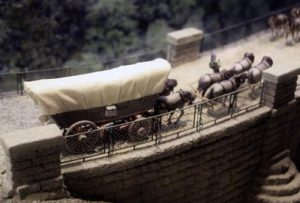
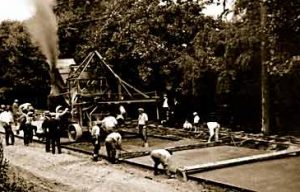 days. These old roads are a great way to relax, take your time and see some sights. Traveling the National Road, you can see the timeless little villages with small restaurants where you can get a home cooked meal and a trip back in time. The Interstate often parallels the National Road, but we leave behind the old inns and farmhouses in our rush to arrive about destination.
days. These old roads are a great way to relax, take your time and see some sights. Traveling the National Road, you can see the timeless little villages with small restaurants where you can get a home cooked meal and a trip back in time. The Interstate often parallels the National Road, but we leave behind the old inns and farmhouses in our rush to arrive about destination.
 With everyone arguing about whether or not religion has a place in politics, today seemed a good day to discuss the common misconception people have about the constitutional amendment they so often quote as the basis for their arguments. Our founding fathers came to this country, largely because in England they were forced to attend the Church of England…by law. Whether they agreed or not, or even whether the church was teaching correctly or not, was completely irrelevant. That was the church, and that was where people were expected to go. For any who wonder why so many of us are against the influx of Muslims, this is the reason…not because we disagree with their religion, but because it is the goal of Islam to force the entire world to convert to Islam. Our founding fathers, and indeed most Americans believe so strongly in the right to choose which religion, or even the lack of a religion, we want to practice, that we are willing to fight to keep that right. This amendment is simply not negotiable.
With everyone arguing about whether or not religion has a place in politics, today seemed a good day to discuss the common misconception people have about the constitutional amendment they so often quote as the basis for their arguments. Our founding fathers came to this country, largely because in England they were forced to attend the Church of England…by law. Whether they agreed or not, or even whether the church was teaching correctly or not, was completely irrelevant. That was the church, and that was where people were expected to go. For any who wonder why so many of us are against the influx of Muslims, this is the reason…not because we disagree with their religion, but because it is the goal of Islam to force the entire world to convert to Islam. Our founding fathers, and indeed most Americans believe so strongly in the right to choose which religion, or even the lack of a religion, we want to practice, that we are willing to fight to keep that right. This amendment is simply not negotiable.
Nevertheless, the misconception comes when people misstate the first amendment, claiming that it means that religion has no place in politics. That statement is fundamentally wrong, and not what Thomas Jefferson had in mind when in 1779, he wrote the “Bill for Establishing Religious Freedom.” America was settled by people who wanted religious freedom, and Jefferson believed in freedom of religion, too. He didn’t believe that churches  should be funded by taxes, thereby giving the government authority in the beliefs of the church. The bill said that “no man shall be compelled (forced) to frequent (go to) or support any religious worship, place or ministry whatsoever.” Some people were against it even then, and it did not become law at that time. It did, however, create a friendship between Jefferson and James Madison, who believed the say way.
should be funded by taxes, thereby giving the government authority in the beliefs of the church. The bill said that “no man shall be compelled (forced) to frequent (go to) or support any religious worship, place or ministry whatsoever.” Some people were against it even then, and it did not become law at that time. It did, however, create a friendship between Jefferson and James Madison, who believed the say way.
In 1784, Jefferson left for Paris, France to perform his duties as US foreign minister to France. That left James Madison with the task of making the bill into law. No easy task, because it had failed on its first attempt. Undaunted, Madison presented the bill to the Virginia Assembly, and with a few minor changes, it passed in 1786. Elated, Madison sent word to Jefferson in Paris. When the bill passed, Virginia became the first state to free religions from state rule. It is still part of Virginia’s constitution. It was used as a model for other state’s constitutions. It was also used as a model for the religious language in the Bill of Rights: “Congress shall make no law respecting an establishment of religion, or prohibiting the free exercise thereof.” If people would read the Constitutional amendment and the Bill of Rights carefully, they would, indeed find that it says nothing at all about keeping religion out of politics, and everything about keeping the government out of religions. Thomas 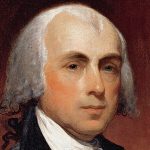 Jefferson believed the Virginia Statute of Religious Freedom was one of his greatest achievements. So strongly did he believe in his accomplishments, that he wanted his tombstone to list the “things that he had given the people.” It reads: “Here was buried Thomas Jefferson Author of the Declaration of Independence of The Statute of Virginia for Religious Freedom And Father of the University of Virginia.” Why did Jefferson want the Statute for Religious Freedom on his tombstone? It was because he could see what could happen when one religion was allowed to hold hostage the rest of the nation, or indeed, the world. That is why we will never give up the fight, and we will oppose all religions that would try to force themselves on us. People should stop using this convenient misconception to try to further their own agendas in this nation.
Jefferson believed the Virginia Statute of Religious Freedom was one of his greatest achievements. So strongly did he believe in his accomplishments, that he wanted his tombstone to list the “things that he had given the people.” It reads: “Here was buried Thomas Jefferson Author of the Declaration of Independence of The Statute of Virginia for Religious Freedom And Father of the University of Virginia.” Why did Jefferson want the Statute for Religious Freedom on his tombstone? It was because he could see what could happen when one religion was allowed to hold hostage the rest of the nation, or indeed, the world. That is why we will never give up the fight, and we will oppose all religions that would try to force themselves on us. People should stop using this convenient misconception to try to further their own agendas in this nation.

